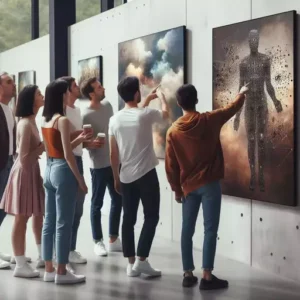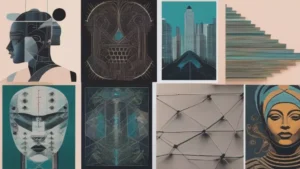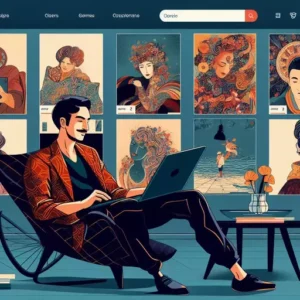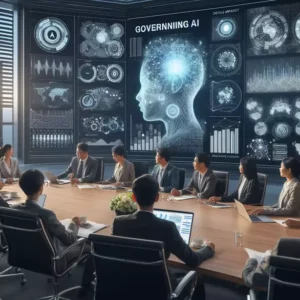AI Art vs Human Art has started big arguments about whether AI can be as creative as human artists. Hard questions have come up about what creativity is, ethics, and copyright as AI gets better at making art from text. Can art by machines ever create the culture and views that great artists show in their work?
Let us explore this debate through an in-depth examination.
The Explosive Growth of AI Art
Recent advances in AI, such as deep learning and generative adversarial networks, have allowed algorithms to analyze millions of images and artworks. This has enabled them to identify visual patterns. Major tech companies and startups have invested billions in developing models that can generate new, realistic visual combinations creatively.
Most popular Image generation platforms like DALL-E 3, Midjourney, and Stable Diffusion empower users to simply type text prompts to instantly generate incredibly realistic and imaginative art. Users can become overnight “artists” without needing any training in actual artistic skills.
AI art startups have increased. They are drawing venture capital and leading users to make, show, and sell AI artwork. From a new technology just years ago, AI art seems set to radically change art and visual culture. The fast progress in AI art models points to a future where AI has a major part in art creation.
How Does AI Image Generation Work? A Beginner’s Guide
Why People Like AI Art

Trying New Things
AI art isn’t limited to human artists. It can mix many styles, times, and types of art in endless new ways. It can try millions more ideas than any person could in their life.
New and Imaginative
AI art isn’t stuck following rules and biases people have. It often surprises people with weird mashups they wouldn’t think of. AI art can imagine strange things way beyond what makes sense to us.
Art for Everyone
AI art lets anyone make nice-looking art without learning special skills. It makes creating original work easier for casual hobbyists.
Fast and Customized
For creative folks and businesses, AI allows more art faster than humans could make. It can make tons of personalized versions.
Business Opportunities
AI art also opens up new ways to make money, like NFTs, subscriptions, and content. It can produce an abundance of art to sell in ways no human could.
Pushing Art Forward
Not limited by traditional materials, AI can make new kinds of art like interactive or infinite zoom designs. It expands art’s boundaries beyond what humans can easily do.
Stable Diffusion Negative Prompts: A Comprehensive Guide with Practical Examples
The Soul and Spirit of Human Artistry
However, human art expresses emotional depth, cultural perspective, and meaning that AI art does not replicate:

Imagination, Emotion, and Meaning
Human art emanates from profound emotions, introspection, curiosity about the world, and cultural influences. It channels the richness, messiness, and magic of the human condition – concepts still opaque to algorithms.
Developing a Unique Voice
Human artists hone their distinctive visual voice and style over years of experimentation. Their works document cultural/historic milestones and social issues through an original perspective.
Artistic Traditions
Human creativity builds on time-honored artistic traditions while evolving them into fresh new styles and techniques. AI cannot yet replicate art’s cumulative impact across eras.
Imperfections and Textures
The subtleties of human touch, mistakes, and textures – aspects AI models yet struggle to recreate – lend authenticity and emotional resonance.
Reinventing Artistic Norms
Human artists upend norms by creating revolutionary new styles that reflect their life experiences. AI art relies on human norms and conventions to function.
Cultural Context and Meaning
Unlike AI, humans create art reflecting cultural contexts, and social narratives and by channeling meaningful life experiences. This lends art deeper resonance.
AI-Art Related Statistics
- 56% of individuals who have observed AI art find it enjoyable. (Source: YouGov)
- More than 50% of the population can still distinguish AI-generated art. (Source: Yale Daily News)
- It’s simpler to identify AI-created cats than AI-created humans. (Source: Tidio)
- AI-generated creations are deceiving experts and securing awards. (Source: BBC News)
- Many Japanese artists worry that AI will affect their income. (Source: Arts Workers Japan Association)
The AI Art Market Heats Up
The AI art market has exploded as platforms enable users to generate and sell AI art:

- Generative NFTs became the third-largest NFT category, with a trading volume surpassing $1.8 billion by July 2022.
- In 2021, Christie’s auctioned an AI portrait for $432,500, a staggering 40 times its initial estimate.
- By October 2022, Stable Diffusion had attracted over 10 million daily users, according to Forbes.
- The entire AI market is projected to approach nearly $2 trillion by 2030, as reported by NextMSC.
- The highest-priced piece of AI art sold through traditional means fetched $432,000, as highlighted by BBC News.
- More than 50% of individuals can still distinguish AI-generated art, as per Yale Daily News.
- An astounding 89% of artists believe that copyright laws require updates to account for the impact of AI, according to findings from Book and Artist.
For human creatives, AI offers opportunities to increase output. But easy monetization risks flooding the space with derivate art and draining art of deeper meaning.
Key Research Directions for Responsible AI Art
- Developing algorithms that codify ethics and cultural meaning to supplement generative artistic capabilities.
- Using AI to statistically analyze art’s impacts on society throughout history and modeling future implications.
- Creating collaborative, ethical datasets and benchmarks to advance socially responsible AI art.
- Architecting transparent AI models that acknowledge sources, provide attribution, and give users creative control.
- Building inclusive AI art platforms accessible to disadvantaged groups and integrating human mentorship.
- Incentivizing interdisciplinary research bridging arts, ethics, and technology.
- Evolving new fields like AI Art Studies to deepen cultural understanding between humans and intelligent machines.
AI Art Brings Up Worrying Ethical Questions
AI art also raises a lot of concerning questions:
- Training data often violates the copyrights of human artists whose work was scraped without consent
- It risks the commodification of art and diminishing human creativity into mass-produced content
- The sizeable carbon footprint from computational resources may outweigh the benefits
- Lack of regulation risks art becoming a vapid plaything shorn of cultural meaning
Governing the rise of AI art responsibly can mitigate these concerns via transparency, copyright frameworks, and labeling of AI art. But complex challenges remain for society a policymakers.
Is AI Art a Helpful Tool or Danger to Artists?
AI art provokes impassioned views spanning techno-optimists to Luddites
The Utopian View
- AI will unlock creativity for all and empower human artists with wondrous new tools.
- It will democratize art, unleash radical creativity, and drive progress.
- AI art expands the horizons of what is artistically possible.
The Dystopian View
- AI art will devastate the livelihoods of human artists and drain art of meaning.
- It heralds an Orwellian future where art is mass-produced by machines as culture crumbles.
- Uncreative algorithms will homogenize art into cookie-cutter corporate content.
The Balanced View
- AI art has virtues but also profound limitations compared to human art.
- With prudent cooperation, humans and machines can positively inspire each other creatively.
- AI art is best suited to aid human artists rather than replace them.
Eastern Perspective
- Some Eastern philosophies have long accepted tools as extensions of human creativity rather than threats to it.
- Buddhism’s concept of “skillful means” views tools as pragmatic methods to achieve outcomes aligned with right living.
- Confucianism’s “rectification of names” principle implies creating ethical frameworks to positively direct new tools like AI.
Western Perspective
- The West has harbored more anxiety about technology usurping humanity, from the Luddites smashing machines to Mary Shelley’s Frankenstein.
- But Western thinkers like Marshall McLuhan also recognized technology’s promise to upgrade humanity rather than just replace it.
- Western faith in rational problem-solving can guide the development of technical and ethical standards for AI art.
Global Perspective
- Shared global values of justice, responsibility, and human dignity can shape AI art’s trajectory positively.
- Responsible international cooperation is key, as AI art transcends geographical boundaries.
- Keeping human creativity and ethics central while embracing technical innovation is crucial for global harmony.
Key Challenges in Governing AI Art

- How to balance free artistic expression and ethical risks?
- Should derivative art divulge its AI origins or can it be passed off as human-made?
- Who owns the rights to images created by AI – the artist, programmer, or company owning the algorithm?
- How to regulate an artistic process that transcends physical artwork?
- Can the law evolve fast enough to govern rapidly emerging technology?
- How to equitably distribute rewards from AI art to compensate the human artists whose work is trained by algorithms?
- Does society risk complacency by over-relying on AI rather than developing human creativity?
The Path Forward For AI Art
Managing the growth of AI art sustainably poses tricky technical, ethical, and philosophical challenges. But thoughtfully using its potential while addressing risks could lead to people and AI inspiring each other to amazing new creativity. Some sensible steps forward may be:
- Making rules so AI art is transparent in origins, prevents misuse, and limits environmental harm.
- Updating copyright and rewards to acknowledge the human artists whose work trained the AI models.
- Making AI art widely available but teaching people about the unique cultural role of human art so we don’t depend on AI too much.
- Promoting discussion of AI art’s impacts on society to guide its path in a good direction.
The Final Thoughts on AI Art vs Human Art
Right now, AI art is more of an interesting tech trick than great art that moves people. While it shows some creativity, AI art can’t yet match the cultural importance of art made by humans over time.
AI art may find a place as a helpful tool to boost human creativity. But it can’t recreate the mix of social stories, feelings, memories, and life experiences that humans share through art. The future of AI art relies on using it for good things while limiting bad impacts.
With careful teamwork, human imagination and AI skills could inspire each other to amazing new heights. But we need to protect the special value of human art as the AI art revolution happens.
2 Responses